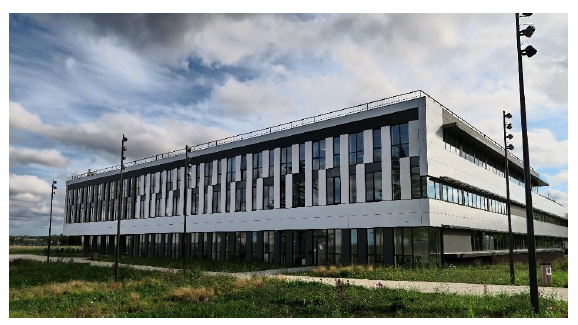Inaugurated on 19 November 2019, the Infrastructure for Climate and Environmental Sciences (ICE) accommodates nearly 300 people from the LSCE along with their equipment. These scientists are mainly from CEA, CNRS and the University of Versailles Saint-Quentin-en-Yvelines.
Located at the CEA research center in Paris-Saclay, the building has received funding from the State, particularly through the Investing in the Future Program as well as from the Île-de-France Region and the Essonne department.
LSCE teams are internationally recognized for their expertise and the quality of their research. Inaugurated on 19 November 2019, this emblematic building for climate sciences provides them with a research center that meets the highest standards worldwide. Today, most of the 300 people that work in the laboratory (engineers, researchers, technicians, research lecturers and students) are based in this building.
ICE is also likely to attract foreign scientists and economic stakeholders. It aims to draw in start-ups and SMEs that are hoping to enhance their technological expertise and develop climate services.
The skills pooled at ICE
The LSCE brings together teams on the subject of the environment and climate change, natural variations in the climate and those induced by human activities, and its link with the carbon cycle and the evolution of CO2. This research contributes to addressing the major challenge of diagnosing and adapting to climate change, both to inform society's knowledge of climate phenomena and to provide factual and accurate scientific information to citizens and political and economic stakeholders.
The laboratory's activities are organized into three major topics:
1. Archives and Tracers: natural variability or human impact?
2. Biogeochemical Cycles and Transfers to the Environment
3. Climate and Cycles – Modeling their variability and interactions
Already strongly involved in the international work of the IPCC (2), the LSCE coordinates many international projects on climate modeling and reconstruction, climate projections, environmental change and the interactions between the climate, the carbon cycle and ecosystems. Within the Institut Pierre-Simon Laplace (IPSL), the LSCE manages the European research infrastructure project ICOS (3), a greenhouse gas monitoring network, the European project Clim4energy (4) for the development of climate services, in synergy with the French National Space Agency (CNES) for space projects and in cooperation with industries, major groups and SMEs.

A structure dedicated to the study of the climate and the environment
The ICE project is part of the world-class science and technology cluster on the Saclay site. This new addition initiates the reconfiguration of the CEA Orme des Merisiers site.The building is set on a dark and reflective base, which structures its relationship with the ground, both absorbing and projecting the plant-covered foreground, the meadow and the square. The two faces to the north and the east look out over the town and the campus.The largely green roof is home to an experimental terrace, which occupies one level and is open-air, causing the horizontal lines to stretch out even further, finally leading to a very low building to the south, facing the other mainly single-story buildings on the site, like the neighboring Synchrotron Soleil facility.


The ICE Center brings together most of the teams from the Laboratory of Climate and Environmental Sciences (LSCE, CEA/CNRS/UVSQ). The over 25,000-m2 infrastructure, designed by the architectural firm Celnikier & Grabli, accommodates 300 people and their equipment of the highest international standard dedicated to climate and environmental sciences.
© Didier Touzeau / CEA
(1) Orme des Merisiers, CEA Paris-Saclay
(2) The Intergovernmental Panel on Climate Change (IPCC) is tasked with assessing international scientific, technical and socio-economic data on climate change as accurately and comprehensively as possible.
(3) The Integrated Carbon Observation System (ICOS) network is a group of stations used to measure greenhouse gas concentrations and flows in Europe and adjoining regions. It operates on three levels: atmosphere, ecosystems and oceans. Its objective is to better understand greenhouse gas emission and transport processes in order to improve how they are represented in climate models.
(4) Clim4Energy: the European project Clim4Energy, a service demonstrator of the European program Copernicus Climate Change Service, provides targeted climate data on issues in the energy sector. This public data is made available to industries and decision-makers to help them to define their investment and operating strategies.